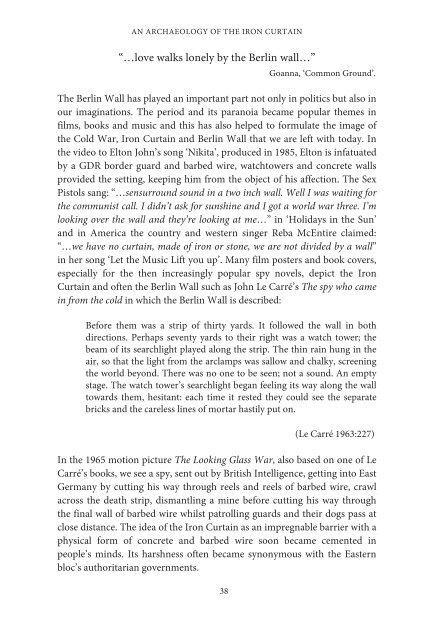1JZGauQ
1JZGauQ
1JZGauQ
You also want an ePaper? Increase the reach of your titles
YUMPU automatically turns print PDFs into web optimized ePapers that Google loves.
AN ARCHAEOLOGY OF THE IRON CURTAIN<br />
“…love walks lonely by the Berlin wall…”<br />
38<br />
Goanna, ‘Common Ground’.<br />
The Berlin Wall has played an important part not only in politics but also in<br />
our imaginations. The period and its paranoia became popular themes in<br />
films, books and music and this has also helped to formulate the image of<br />
the Cold War, Iron Curtain and Berlin Wall that we are left with today. In<br />
the video to Elton John’s song ‘Nikita’, produced in 1985, Elton is infatuated<br />
by a GDR border guard and barbed wire, watchtowers and concrete walls<br />
provided the setting, keeping him from the object of his affection. The Sex<br />
Pistols sang: “…sensurround sound in a two inch wall. Well I was waiting for<br />
the communist call. I didn’t ask for sunshine and I got a world war three. I’m<br />
looking over the wall and they’re looking at me…” in ‘Holidays in the Sun’<br />
and in America the country and western singer Reba McEntire claimed:<br />
“…we have no curtain, made of iron or stone, we are not divided by a wall”<br />
in her song ‘Let the Music Lift you up’. Many film posters and book covers,<br />
especially for the then increasingly popular spy novels, depict the Iron<br />
Curtain and often the Berlin Wall such as John Le Carré’s The spy who came<br />
in from the cold in which the Berlin Wall is described:<br />
Before them was a strip of thirty yards. It followed the wall in both<br />
directions. Perhaps seventy yards to their right was a watch tower; the<br />
beam of its searchlight played along the strip. The thin rain hung in the<br />
air, so that the light from the arclamps was sallow and chalky, screening<br />
the world beyond. There was no one to be seen; not a sound. An empty<br />
stage. The watch tower’s searchlight began feeling its way along the wall<br />
towards them, hesitant: each time it rested they could see the separate<br />
bricks and the careless lines of mortar hastily put on.<br />
(Le Carré 1963:227)<br />
In the 1965 motion picture The Looking Glass War, also based on one of Le<br />
Carré’s books, we see a spy, sent out by British Intelligence, getting into East<br />
Germany by cutting his way through reels and reels of barbed wire, crawl<br />
across the death strip, dismantling a mine before cutting his way through<br />
the final wall of barbed wire whilst patrolling guards and their dogs pass at<br />
close distance. The idea of the Iron Curtain as an impregnable barrier with a<br />
physical form of concrete and barbed wire soon became cemented in<br />
people’s minds. Its harshness often became synonymous with the Eastern<br />
bloc’s authoritarian governments.




